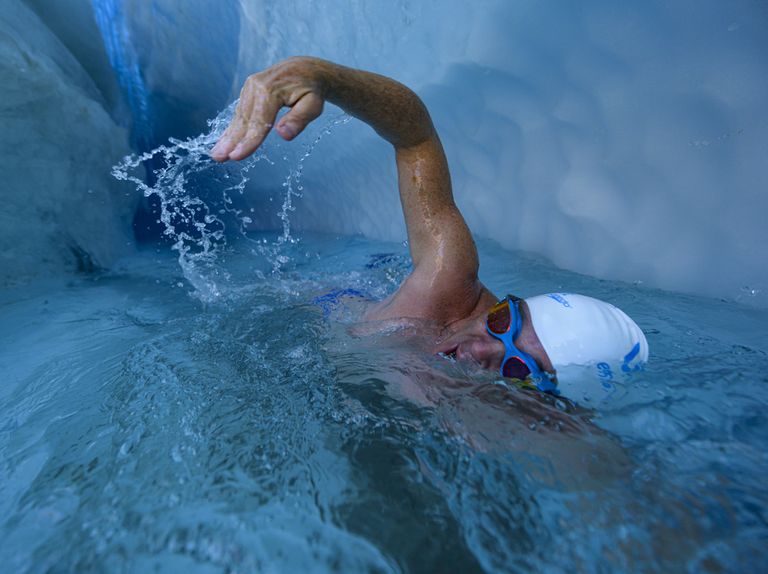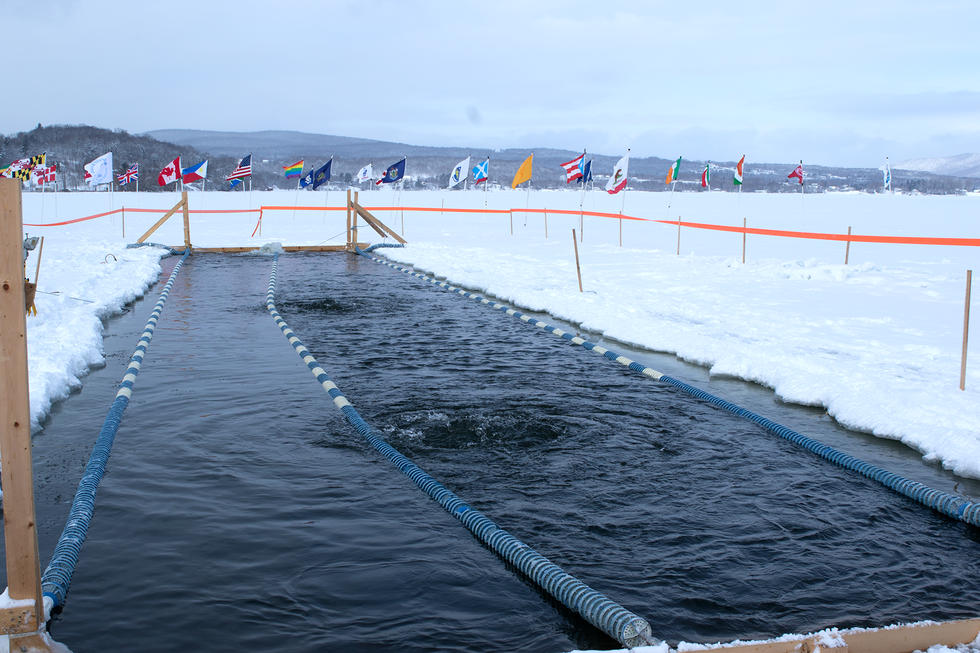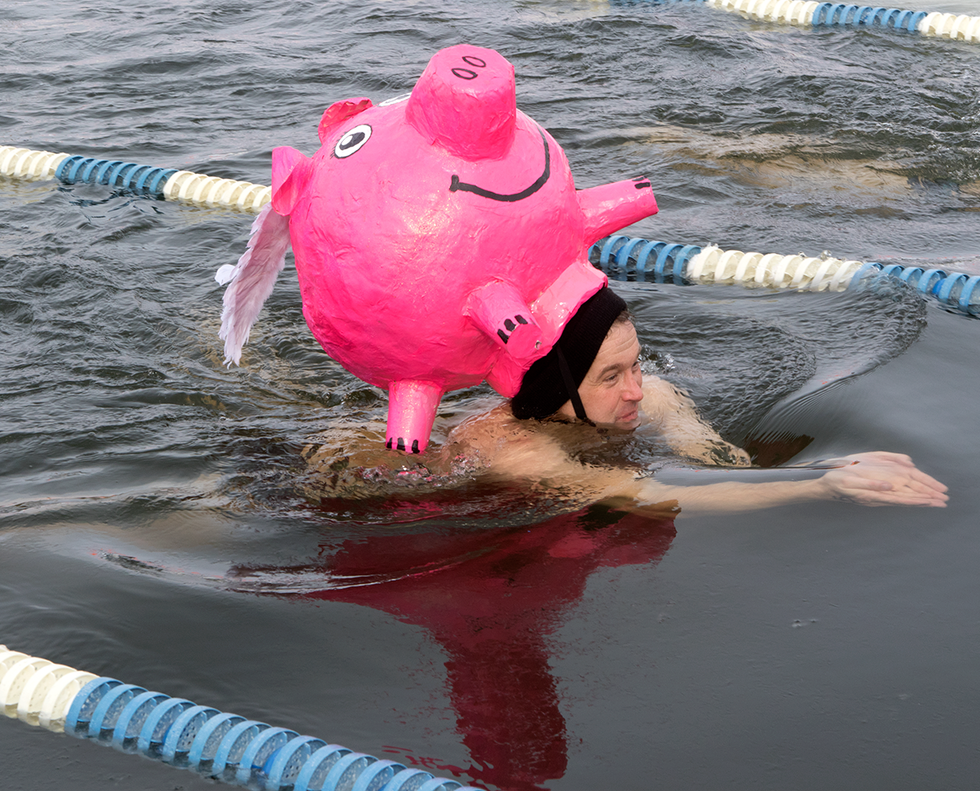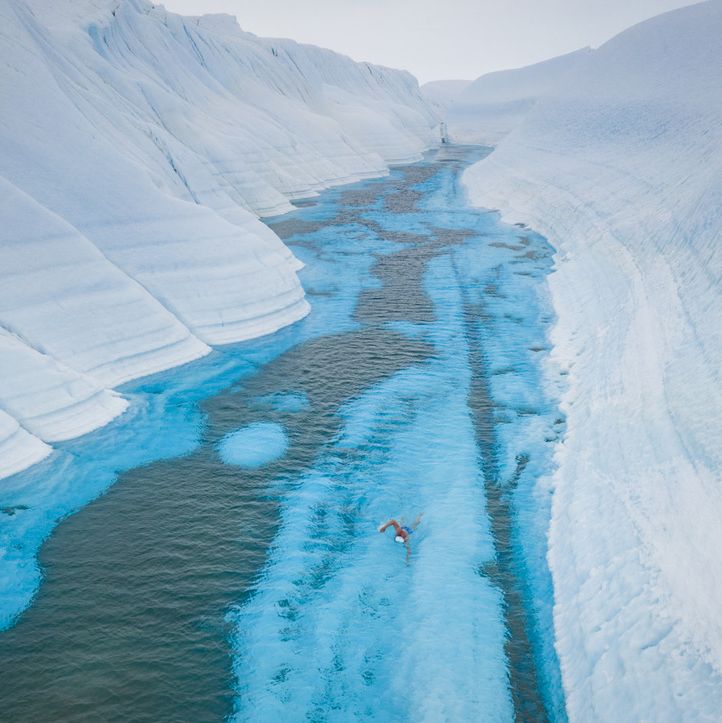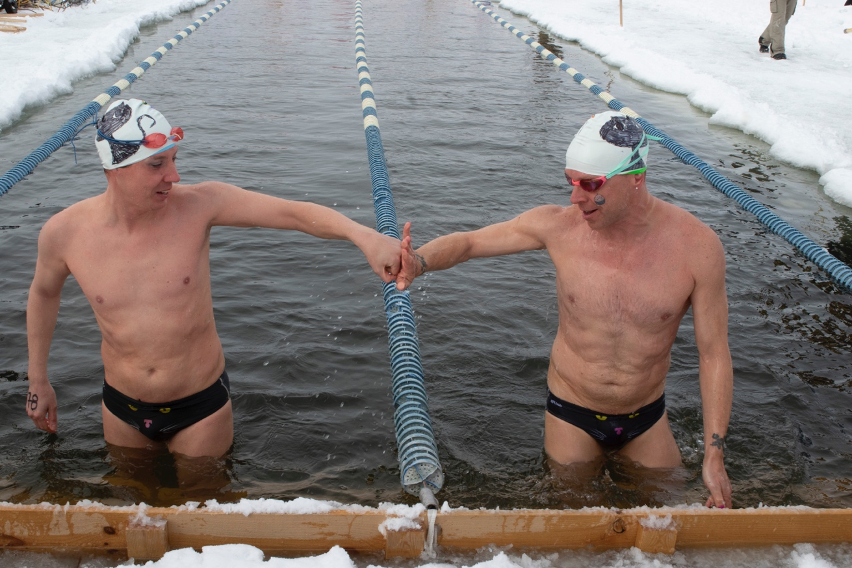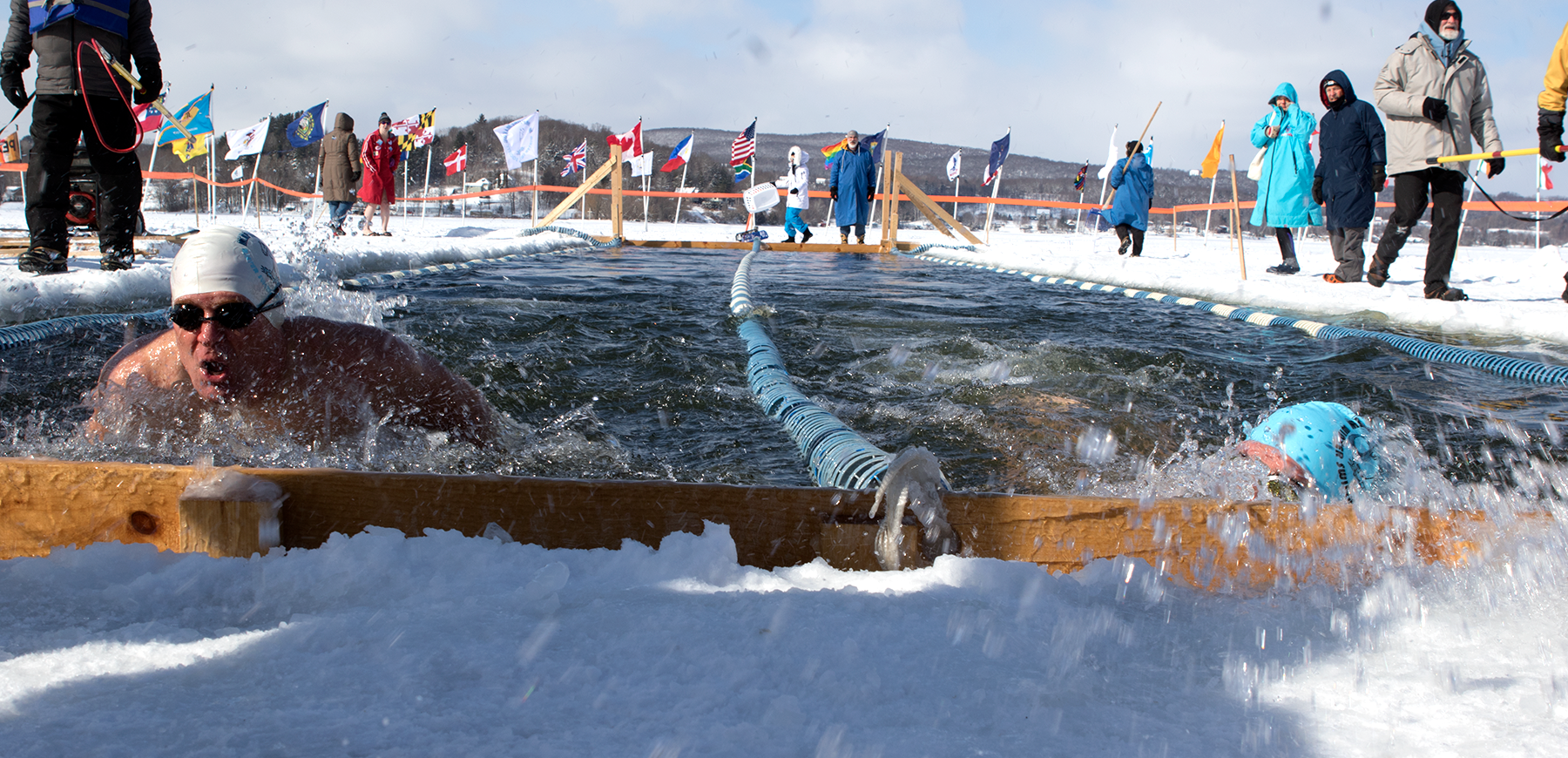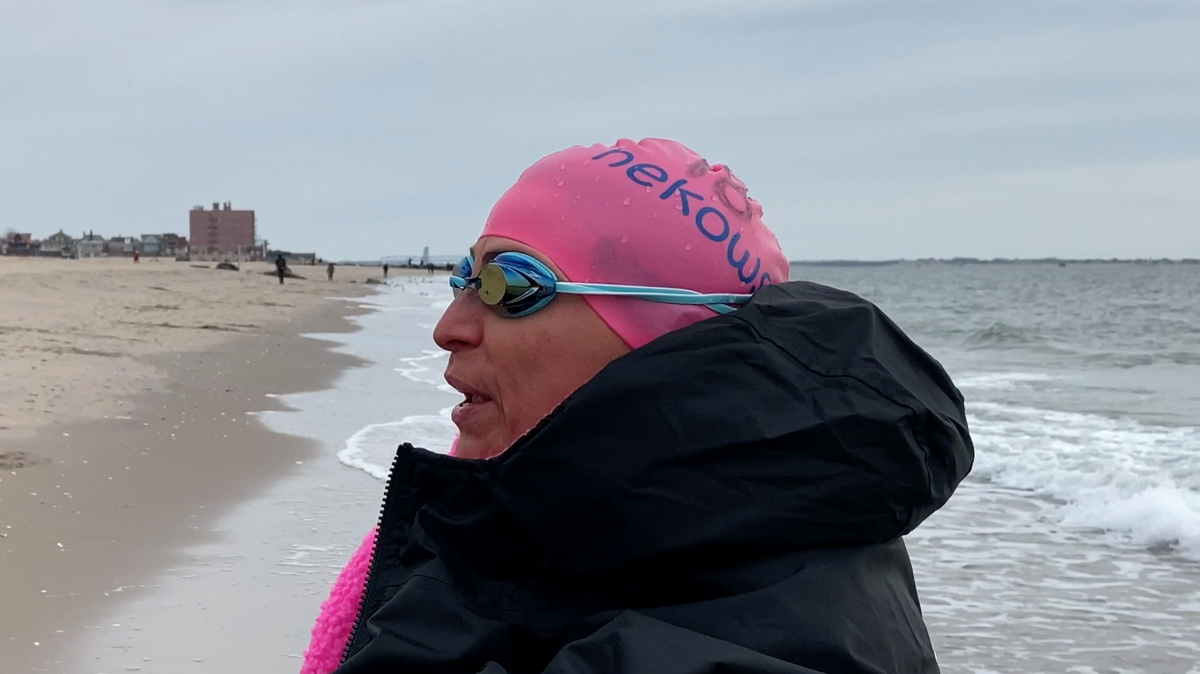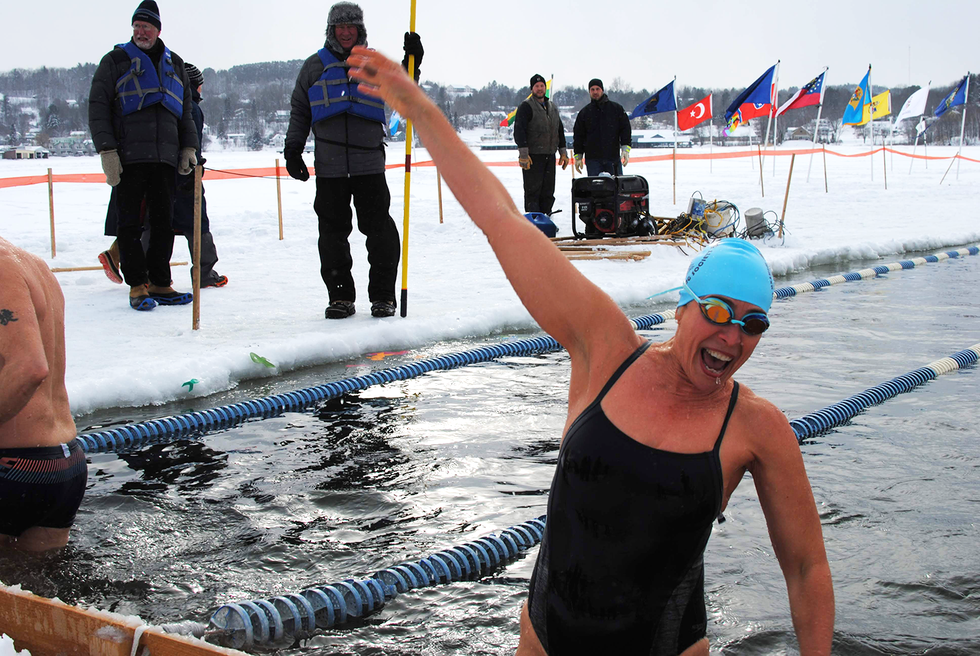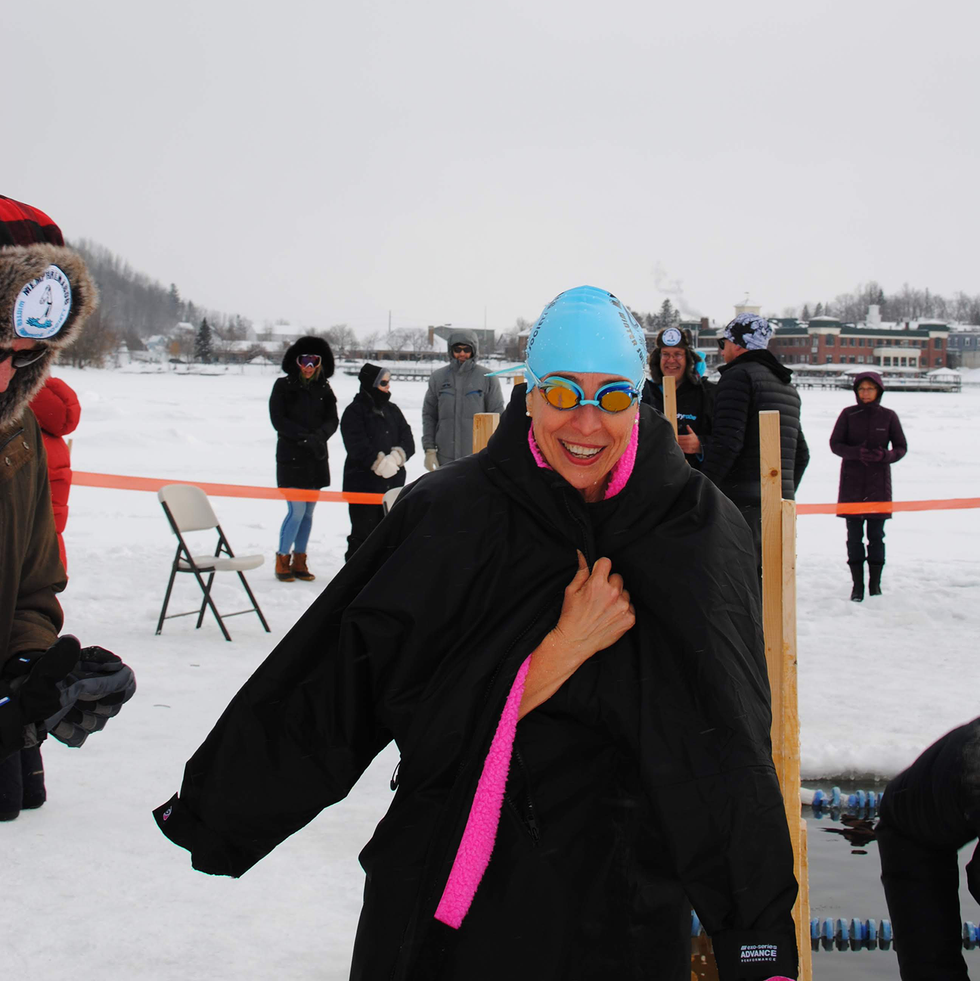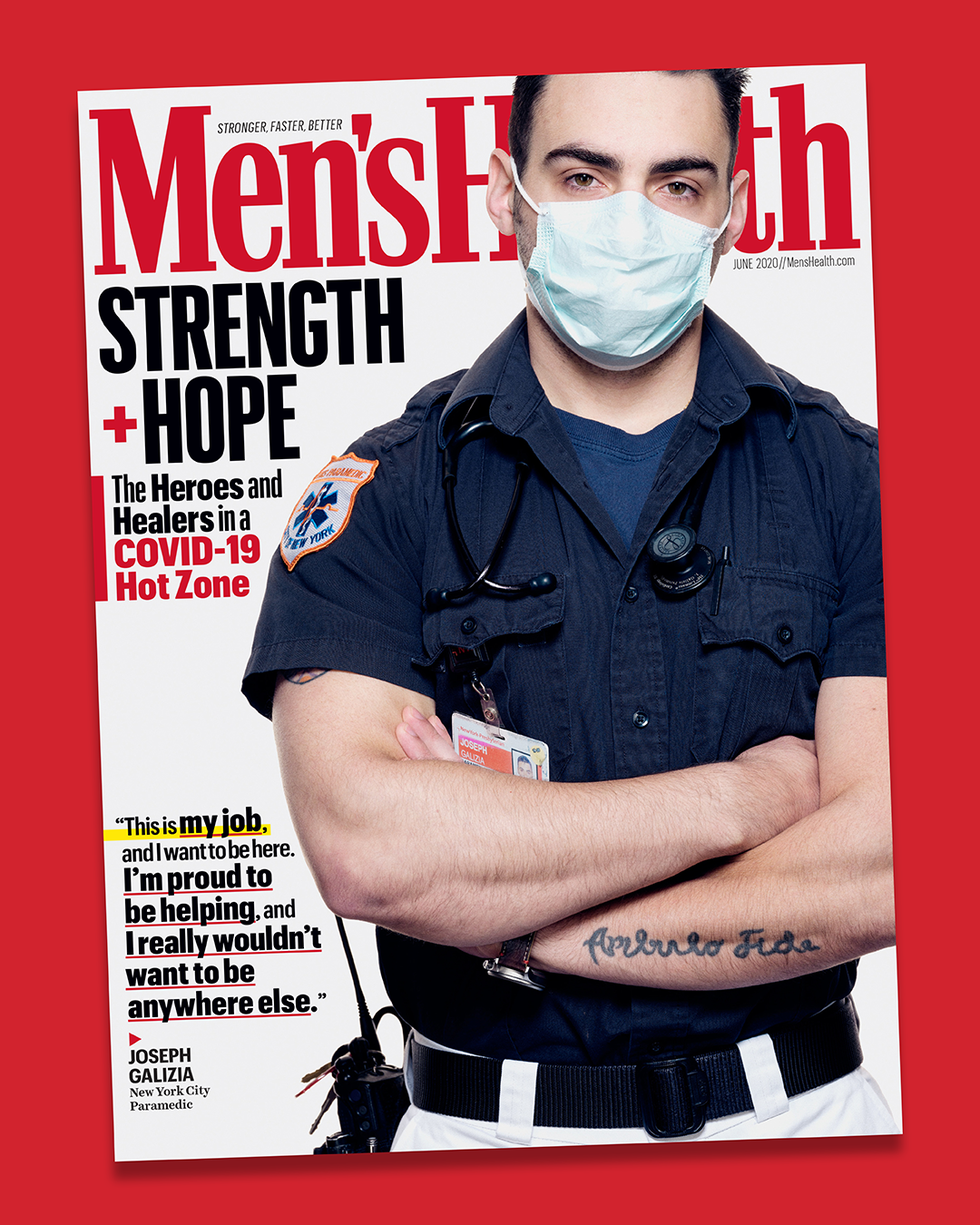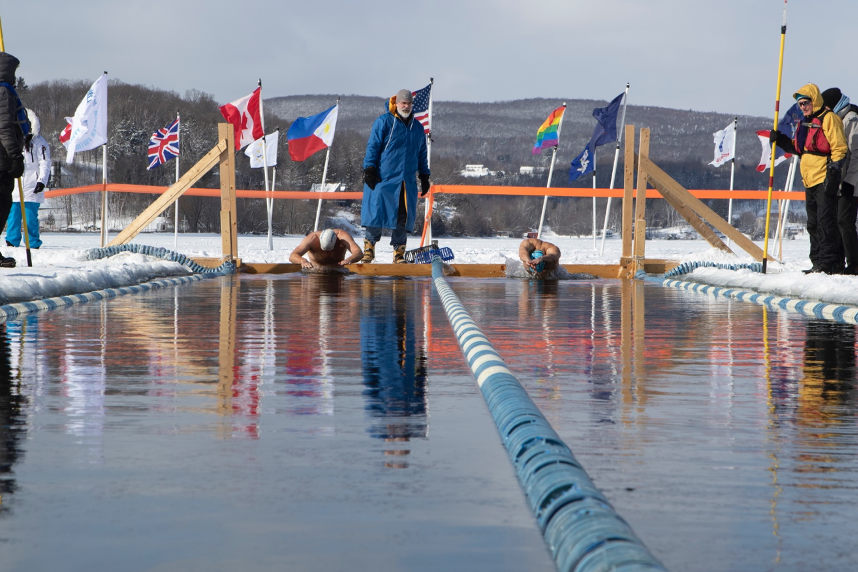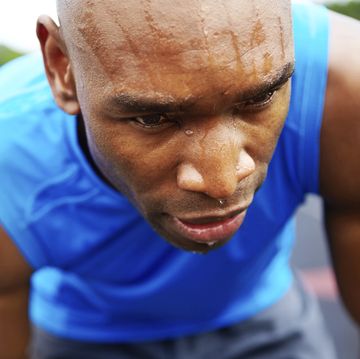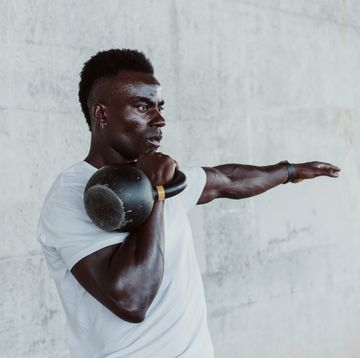"I DON'T WANT to scare you, but if you don’t have a little anxiety about being out there, don’t go out,” says Greg O’Connor to the 93 swimmers who have committed to launching themselves—at various times over the next two days—into a lap pool that has been carved into the thick ice of Lake Memphremagog in Newport, Vermont.
It’s a Saturday morning in late February, and O’Connor, 51, who serves as safety director for the annual Memphremagog Winter Swim Festival, is holding a quick briefing inside the East Side Restaurant and Pub, a tavern that doubles as a staging area just a few hundred feet from the competition zone.
As basically the only subzero meet in North America, the Winter Swim Fest is free to make its own rules. The frigid “pool” is limited to two lanes and 25 meters. Races range from 25 to 200 meters and include the classic swim-meet strokes of freestyle and butterfly and various relays. While parka-clad volunteers clock times, competitors’ race attire must be chillingly confined to English Channel rules: just a cap, goggles, and a standard swimsuit.
This setup means no flip turns. (“If you turn wrong, you end up under the ice,” O’Connor says.) No holding the ladder or the wall too long at the end. (“It gets icy, and your hand can freeze to it.”) And no matter what, you need to stay in touch with how you’re feeling. (“You can go downhill really fast.”) The popularity of ice swimming has spiked in recent years, so about half the field at Winter Swim Fest is new. If you don’t have anxiety, O’Connor clarifies, “it means you have no idea what you’re getting yourself into.”
It all started out as a half-joke deep in the winter of 2014. Race director Phil White, then in his mid-60s, posted a photo of himself on Facebook standing on the ice of Lake Memphremagog with a three-foot circular saw and the now-infamous phrase “Anybody want to go for a swim?” Then Darren Miller, a marathon swimmer and race organizer in Pittsburgh, saw the post and called to ask, “Are you serious?” One year later, 40 hardy swimmers turned up for the first event, and over the next half decade participation doubled with little obvious reward at stake.
Bragging rights and pool records aside, the top finishers receive little more than Vermont maple syrup and a lot of homemade beef jerky (for first place), or a little less beef jerky (for second), which hints that there must be some stronger pull below the surface. After the briefing, several swimmers around me chatter nervously about how maybe this whole thing wasn’t such a good idea. I can empathize. I’m a devoted warm-water marathon swimmer and can’t get my head around the draw. So I’ve signed up to participate in the 25-meter breaststroke. In less than five hours, I too will be forcing myself into the frigid water.
THE WINTER SWIM Festival always kicks off with the hat competition, a true icebreaker of an event: a 25-meter head-up breaststroke that’s judged not on your speed but on your hat alone. It’s a showcase of creativity and engineering, with some headgear accessorized by lights and waterproof speakers.
Among this stream of contestants now heading toward the water, Derek Tucker, 49, stands out for wearing a bright pink papier-mâché pig hat so voluminous you could probably see it from space. He and his kids designed it together, he explains, regarding it with a mixture of pride and trepidation. He’s fully aware that he’s broken the classic “nothing new on race day” rule by not test-captaining The Hat beforehand. Despite being an ultraswimmer and ultrarunner, he’s not sure he can actually keep his head above water while wearing it. “Worst case, I’ll just tread water and scull,” he says, shortly before descending into the pool.
A few minutes later, he’s in, and struggling. Halfway down the lane, heat-mate Thomas Young-Bayer, 40, glances over from under his modest cephalopod hat to make sure the pig (and Tucker) is making it. That simple glimpse reveals how this festival goes. How winter swimming goes. These people compete with one another second, watch out for one another first. “I was looking to see if he was keeping his hat on,” Young-Bayer says afterward. “And I noticed I was starting to get a little ahead of him, so I slowed down, because the hat competition is an exhibition, not a race.”
The aquatic parade of hats continues, with plenty of woo-hoos and laughter at the finish. Tucker, the pig-cap creator, tells me that the whole winter swimming experience is “deliciously silly and unnecessary.” That may not seem like a totally healthy combination but you’d be surprised.
Cold-water swimming is considered “ice swimming” when it’s done at temperatures of 5 degrees C or less, about 41 degrees F. That’s not any kind of play-around temperature if you’re going to actually get in and do more than a polar-bear-plunge dip. So to qualify for the Memphremagog Winter Swim Festival, swimmers must confirm that they’ve swum at least half the length of their designated event beforehand in water that’s 41 degrees or colder.
It’s not easy to be in water that cold for very long. While it takes about 30 minutes for hypothermia to set in, you can feel sluggish and winded far faster. To avoid complications, the Winter Swim Festival—where the water temperature is 31—sets the time limit for its longest events at four minutes. But that hasn’t stopped people from going longer elsewhere around the globe. This year’s Winter Swimming World Championships, in Bled, Slovenia, hosted more than 1,000 swimmers from 36 countries and included a one-kilometer (or 1,093-yard) race that took people between 18 and 34 minutes to complete. And as in any sport, there are extremists pushing things even further by completing ice miles, which are about 50 percent longer.
At Lake Memphremagog, the lineup contains some ice milers—notably Elaine K. Howley, who has also earned the triple crown of swimming (crossing Catalina Channel and the English Channel and circumnavigating Manhattan)—and a little bit of everyone else. They range in age from 12-year-old Gabriel Deschenes to 77-year-old Anne Coen. The swimmers vary from lean to Rubenesque and run the gamut from ultrarunners to guys who’ve had cancer and heart attacks, and even some who aren’t all that nuts about going in water over their heads.
Plenty of high-profile cold-water advocates, like Wim Hof and Britain’s Ross Edgley, espouse the health benefits of exposing yourself to extremely cold water for several minutes at a time. But the diverse pods of people who have turned up in Vermont seem driven by something more communal. They’ve arrived from places like Massachusetts, Maryland, Ontario, Ohio, Pennsylvania, and even Ireland, and they have cheeky team names like the Buckeye Bluetits, the Penn Herons, and Boston’s L-Street Brownies, who sport T-shirts with the slogan “When L freezes over.”
AFTER A FEW hours of competition, some of the shorter events give way to the 200-meter freestyle, the longest and coldest contest of the day. A little more than 30 swimmers line up inside the East Side Restaurant and Pub, including Louise Hyder-Darlington of the Penn Herons, who stares out the door into snow. “It’s focus time,” she says under her breath, unsmiling, half to herself, half to a teammate.
At Memphremagog, hypothermia may not be a danger, but that doesn’t diminish the shock of the cold, which can hit hard, make your heart beat faster, and literally take your breath away. Rick Born, 57, a returning Winter Swim Festival contender who’s also swum in competitions abroad, admits that getting in “feels like someone took a large steel band and clenched it around your chest.” That can make you involuntarily gasp for air and suck in water, which is part of why people who fall into icy waters often drown quickly.
The good news is that the more often you get into cold water, the more you can temper that response, says Michael Tipton, a professor at the Extreme Environments Laboratory, part of the Department of Sport and Exercise Science at the University of Portsmouth in the UK. Even five to ten three-minute immersions within a short period of time can cut down the involuntary reaction.
In longer events, the next challenge that hits you, Tipton explains, is “the cooling of the superficial nerves and muscles, particularly in the arms, which are very susceptible to cooling due to their high surface-to-mass ratio.” In swimmer speak: “Your muscles get really cold and stop doing what you ask them to, and you slow way down no matter how hard you’re trying. It’s like swimming through Jell-O, I think, or something very viscous,” says Young-Bayer, the cephalopod-hat guy.
Even for ice milers and open-water champions, the 200 in this 31-degree water is no joke. Two of the fastest competitors all day, Christopher Graefe, 45, and Steve Rouch, 39, who wear matching black Speedos with cat eyes and whiskers emblazoned on the front, tear up their first 50 and speed through the first 100, but by the last 25, even they start slowing down. (Rouch wins in a swift 2:38.36, but Graefe will edge him out a few hours later with a 32.93 in the 50 free.)
Ice swimming might not take as long as other extreme sports, but it reveals your vulnerabilities quickly. If you haven’t had good sleep or good food, you feel fatigued faster. The edge of your physical and mental capacity seems closer. Longer-distance ice swimmers love to talk about the exhilaration, the well-being, the focus, the camaraderie, but it takes a second for them to talk about that edge, even if it’s always there.
“I think it’s more mental than physical,” says famed ice miler Howley. You need to focus on what you’re doing and how you’re feeling. Even getting in is mental—and that’s part of the reward. “It can give you confidence in other areas of your life. When your initial thought is ‘I can’t do this’ but you know you got in last week, that carries over,” says Amy Wierman, 52, one of the Penn Herons. A hard day doesn’t seem so hard when you remember what else has challenged you and how you worked through it.
At Memphremagog and at every ice-swimming spot ever, there’s no shame in getting out. Martin McMahon, 57, a long-distance swimmer who sped to a fourth-place finish in the 50-meter freestyle, pulled himself out of the 200 early. “During the race, I knew what I was going to feel like when I finished, and I didn’t want to go through that,” he says. Howley knows the feeling. “You’ve got to have those days when you just don’t feel good and you don’t last as long as you had planned and you get out,” she says. “And you figure out how to move forward from that. That’s all part of it.”
Another return is in the post-race rush. “There’s a feeling of being alive that’s hard to put into words that the cold amplifies,” says Born. “It kind of turns up the game on your senses.” After each event, he climbs out of the water looking ruddy yet animated; he’s got that just-off-an-adventure vibe. The scientific reason for why so many swimmers come out of the water slightly euphoric is that suddenly cooling your skin cues your body to release a flood of mood- and energy-boosting chemicals, explains Tipton. “You become active and alert, and that can last for some time after you leave the water,” he says.
That may help swimmers tough out sensations the average person wouldn’t exactly consider pleasant. “I remind myself that the pain is just my body’s way to protect me,” says Talbott Crowell, 52, a swimmer who’s competed at Memphremagog for the past five years and who this year traveled to the competition from Florida. “The first five minutes—especially when it’s below 60—can be so painful and you think, I don’t want to do this. But when you’re swimming in training, within ten minutes, your body goes numb and there’s this adrenaline and a thrill. I don’t understand it, but it’s incredible.”
HE'S NOT WRONG. Before I could participate in the 25-meter breaststroke, I had to prove that I could withstand some cold. So two weeks before the festival, I headed out to Brighton Beach, near Coney Island, about an hour’s subway ride away from where I live in Manhattan. There I met up with several people who swim during the summer with CIBBOWS, the Coney Island Brighton Beach Open Water Swimmers, who served as both coaches and witnesses. After some quick tips—“Getting in the water has never gotten easier,” one longtime swimmer not-so-reassuringly told me—I found myself wading into the 40-degree surf sans wetsuit with a mixture of curiosity and terror.
Chest deep, I felt that vise start around my chest, threatening any kind of normal breathing pattern. I knew I’d need to get that under control with an exhale before getting flat to swim. “HA,” I said, trying to force air out of my lungs and override the cold-shock response. Nothing. “HAA,” I tried again. “HAAAAAAAAAAAAAA,” I bellowed, lifted my feet off the sand, and started swimming.
Water that cold doesn’t even register as cold. It’s a not entirely unwelcome prickly sensation, if you think about it. Which I wasn’t really doing, because I was too busy counting my strokes, making sure I traveled far enough to earn the privilege of swimming in water about 10 degrees colder. I came out of the surf after three minutes (about six times longer than I needed), my skin on fire from the cold, my face so stiff I was slurring my words, and I felt it. That thing nobody can pin down. This thrilling, exhilarating, total-body, all-encompassing feeling. All I could think was I get it. I went back the next week.
But that was just the tip of the proverbial iceberg. No winter swim is over until you recover, because the afterdrop can be worse than the swim. The icy water pulls your blood from your extremities to your core, and when it starts flowing all over your body again, your cool extremities cool down your bloodstream and your body temperature can actually drop. You can’t warm up too fast, or the warm blood in your core will rush to your skin quickly, causing rapid cooling, low blood pressure, fainting, and worse.
Recovery is an individual thing, depending on the day, your body, and how long you swam. It might take ten minutes, maybe 20, maybe 60. It took me about 15 minutes to stop shivering at Brighton after the first dip; the second was on a sunny day that cut the time and made all the difference. Either way, shivering is good; it’s how you warm up—“It uses skeletal muscle and it’s a form of exercise,” explains Tipton. In fact, you do it at about 40 percent of your VO2 max.
AFTER LUNCH, THE volunteers tend to the pool with skimmers, harvesting the thin layer of ice that crusted over it during the roughly 90 minutes the water was still. The next heats (no pun intended) are for the 50 free and go by fast, maxing at around 1 minute and 20 seconds for the slowest swimmers, but there are more than 50 people participating, so it still takes a while. Shivering swimmers are escorted into the recovery area, a small, warm building that’s part locker room, part first-aid tent, with sofas, blankets, and buckets of room-temperature water to gently thaw your hands and feet.
By about 2:30 p.m., the energy in the warming room shifts as fatigue sets in. “Normally when we ice-swim, you do it once and you have that rush,” says Graefe, one half of the cat-Speedo duo. “But here, we’re doing it again and again throughout the day. It just becomes exhausting,” he says, adding, half under his breath, “Yeah, I want a nap.”
People start to scratch. Ice swimming is tiring, yet nobody would really call this conventional exercise. What passes for “rigorous training” might consist of a ten-minute dip, lots and lots of logistics and clothes, and maybe a sledgehammer or an axe to create the training spot if your local pond or lake freezes over. And maybe that’s part of the appeal. You can get extreme really quickly. It doesn’t take 3,000 feet of climbing on your bike or a 20-mile run. People might come to ice swimming, Howley says, because “it’s a fairly portable, or quasi-accessible, means of doing something really outrageous that looks really hard.”
Like many other competitors, I arrived in Vermont excited to reexperience the icy-hot sensation that I’d felt in my qualifying swims. Like nearly everyone, I grew more anxious as we approached go time. I worried less about completing the swim than about how fast I could get my breath under control once the cold shock hit. In fact, I’d opted for breaststroke so that I could keep my head up the whole way if my body rebelled against me.
Finally the time comes. My heart beats faster than usual as volunteers escort me arm in arm onto the slippery ice deck. They help me kick off my shoes and peel off my DryRobe swim parka and thermal tights so I won’t keep my lane mate waiting. It’s Tucker, the pig-hat guy.
Once exposed, Tucker and I descend some wooden steps on either side of the pool and stand on a submerged platform that runs between them. We take one second to fist-bump, then grab the ice-crusted rail behind us in a set position. Someone shouts “Go,” and we’re off. The adrenaline of the moment takes over, and within a few strokes I’m able to duck my head under the water. My 25-meter race takes all of 25.97 seconds—and even though Tucker beats me to the far wall, I arrive there tingling, ecstatic, and can't stop grinning.
Whether you’ve finished or pulled out early, volunteers at the end of the lane do the same thing, heat after heat, swimmer after swimmer: Bundle, aid, congratulate. The hallmark of this festival, as much as it is the ice pool itself, is the wrap—the move a volunteer does with a towel or giant robe to bundle the swimmer back up when they emerge from the water, skin varying in shades from ruddy to full-on lobster. Now it’s my turn to feel it, as the volunteers make sure my frozen feet get into my shoes and that my robe is zipped.
Earlier, I spoke with one of the fast, young up-and-comers in the sport, the Dutch athlete Fergil Hesterman, 28, who described the ice-swimming community as “one big family that helps each other out.” It’s easy to feel what he means.
MY TIME IN the breaststroke placed me solidly midpack—tenth place out of 21 women—and yet I still spent the rest of that day feeling victorious. I’d tapped into the mind-over-matter part of the sport, which is incredibly satisfying.
Perhaps no one embodies that ideal more than CIBBOWS swimmer Seth Bornstein, who is attending his fifth festival and has recently returned from the international championships in Bled. When we meet, one of the first things he tells me is “I’m the slowest swimmer on world record. That’s verified.” He still swims regularly. “I realized that I know I can do this; I don’t have anything to prove to anyone anymore, especially myself.”
Bornstein, 63, swam in the hat competition, sporting a stuffed turtle atop his cap. It went well, he says, but he decided to scratch his 25 freestyle scheduled for later in the day. For him, it’s not about fast times or specific distances; it’s about just being among the field. “I didn’t grow up athletic,” he says. “I was born with cerebral palsy and I wore a leg brace as a kid. I never thought I could do physical stuff. Those who have known me for a long time are kind of happy. They know it’s something I wanted—to be athletic. It took me 50 years to get to that point. It’s fun.”
Toward the end of the day, more names get crossed out, more people are re-paired up, and in Memphremagog festival style, everyone rolls with it. By dinnertime, it’s like one big Christmas night, people strolling around in their pajamas (wear your PJs, get one free shot of vodka from the bar) and feeling the effects of adrenaline fatigue, pride, and whatever you call the feeling that comes from being with people who totally get you. People who’ve watched you shiver, dare, fail, and do things you never thought you’d do, again and again.
When the sun rises the next day, the outside temperature remains low, with a real feel of nearly zero. That’s lucky, in a way, because it’s an inconvenient time for ice swimming’s popularity to be surging. Warmer weather caused the water at the recent British Ice Swimming Championships to hit a balmy 43.5 degrees—too warm to be considered an ice swim, so no records could be officially counted. At least one extremist, Lewis Pugh, a British-South African endurance swimmer and activist, is embracing that sad fact by doing ever more dramatic swims in places you wouldn’t think humans could flutter-kick, like the North Pole and, recently, a tunnel of melting ice in east Antarctica, to bring attention to global warming.
The second day’s races go much like the first’s, except for the final event, a set of spirited relays that are as much about what’s happening on the deck as in the water. There’s a flurry of activity as swimmers and volunteers race around to coordinate just who’s about to go into the water, and how to make sure everyone exiting the pool is wrapped and cared for. It’s a game of timing and positioning, frequently messed up, always forgiven, with choruses of “Sorry! Sorry!” and “Go! Go!” mingling in the air while volunteers shuffle dry, warm clothes around on deck to get them to the right swimmer at the right moment.
Relays are supposed to be pod against pod, except they’re kind of not. Cheers erupt everywhere—for your team, the other team, the volunteers around the pool. And I find that I’m cheering for everyone else, too. It’s all, as Tucker once warned me, so silly and unnecessary, and yet energizing and fun and empowering to watch. “I think the sport is growing because it connects us to a real feeling of being alive,” says Margaret Gadzic, 41, a soft-spoken swimmer and organizer on the Buckeye Bluetits. “This is something you can do to feel your breath catch, your heart race, and your blood pump in your veins.”
Once the commotion finally stopped, the ice returned, and barely 24 hours later the pool sealed over. You could say that nothing lasts forever. But there’s always someone willing to crack another spot open.

Marty Munson, currently the health director of Men's Health, has been a health editor at properties including Marie Claire, Prevention, Shape and RealAge. She's also certified as a swim and triathlon coach.
